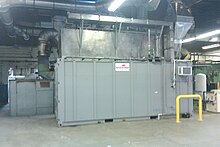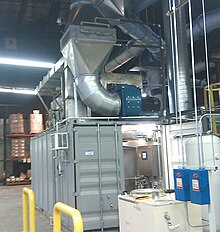Biological oxidizer: Difference between revisions
Randy Glad (talk | contribs) |
Randy Glad (talk | contribs) |
||
| Line 32: | Line 32: | ||
Biological oxidation of organic matters has led to the innovation of a low cost secondary treatment of the waste water emissions and industrial air emissions. The process of [[biodegradation]] offers a very fast method which typically offers 4,000 catalytic cycles per minute. Destruction rate efficiency is generally greater than 99% on most biodegratable organics emissions. The Biological oxidation technology is free from secondary emissions. While other oxidation technologies such as [[thermal oxidation]] produces CO, NO<sub>2</sub> and large amounts of CO<sub>2</sub>. |
Biological oxidation of organic matters has led to the innovation of a low cost secondary treatment of the waste water emissions and industrial air emissions. The process of [[biodegradation]] offers a very fast method which typically offers 4,000 catalytic cycles per minute. Destruction rate efficiency is generally greater than 99% on most biodegratable organics emissions. The Biological oxidation technology is free from secondary emissions. While other oxidation technologies such as [[thermal oxidation]] produces CO, NO<sub>2</sub> and large amounts of CO<sub>2</sub>. |
||
== External links == |
|||
*[http://rto.american-environmental.us/TEAM_VOC_Biological_Oxidizer_System.html Biological Oxidizer Manufacturer] |
|||
== Notes == |
== Notes == |
||
{{nofootnotes|date=May 2014}} |
{{nofootnotes|date=May 2014}} |
||
Revision as of 00:22, 22 May 2014

A biological oxidizer is a device used for wastewater treatment. The biological oxidation processes are used extensively in treating wastewater and volatile organic compounds produced from different commericial or industrial operations. Biological oxidation equipment is utilized to convert biodegradable organic compounds into carbon dioxide and water. The biological oxidation process is a natural occuring process which differs from traditional chemical and thermal oxidizing agents and methods. Some of the more commonly used micro-organisms are: bacillus, coccus, spirillum as well as heterotrophic bacteria which all play important roles in biological degradation process. Generally, these micro-organisms are rod shaped and are facultative. Biological oxidizers provide a stable environment which allows bacteria to naturally oxidize and stabilize a large number of organics in a more efficient manner. Some of the emissions that may be treated biologically include:
- heterocyclic compounds (such as quinoline or pyridine);
- polyaromatic hydrocarbons (PAHs);
- pharmaceutical substances;
- polychlorinated biphenyls;
- radionuclides;
- hydrocarbons (oil);
- benzene, toluene, ethylbenzene, and xylene (BETEX);
- methyl ethyl ketone (MEK);
- some metals.
The prompt removal of a wide range of wastes and pollutants from the environment is the foremost requisite leading to minimal negative environmental impact and sustainability. Microorganisms offer excellent anabolic and catabolic adaptability to degrade and produce stabilized organic matters from contaminants. Microbiology is providing significant views of regulatory metabolic pathways as well as effectiveness to adaption and biological degradation in our changing environment.
Biological destruction mechanism of hazardous air pollutants

Micro-organisms are utilized in biological remediation to control industrial and commercial vapor effluents. When utilizing biological oxidation systems for the remediation emissions, the off gases or vapors are passed through a packed bed having a thin biological film at the surface. The micro-organisms are immobilized into the thin biological film, as the vapor passes over the film they become attached and are oxidized or stabilized.
The biological film accomplishes the degradation process, as the biological sump water is reprocessed over the biomedia it creates additional biological growth and as the film increases so does the biological oxidizers efficiency.
Large surface area and footprint were once required to treat waste water vapor and industrial plant emissions, with the advent of advanced biological oxidation equipment a smaller footprint is required. The footprint will typically occupy the same space as conventional thermal oxidizers.
Biological controls
Excessive formation of the biological film may lead to certain problems such as sloughing, it is an important factor to maintain optimum biological film. Maintaining the biological film is accomplished by proper moisture content. For this purpose the humidity of the air is adjusted within the reacton chamber before the vapor flows over the packing media. The biological packing media may be natural or made of synthetic plastic. Recirculation of the water is always completed in the biological oxidation system to make the system more cost-effective. Biochemical oxygen demand (BOD) indirectly measures the amount of easily biodegradable organic matters thus very low values indicate direct waste water disposal.
The prompt removal of a wide range of wastes and pollutants from the waste gas flow is the foremost requirement of biological oxidizers to meet regulatory permitting requirements. Micro-organisms differ in their ability to rapidly metabolize different pollutants, so the selection of the proper mix of organisms is critical. Research is underway to genetically modify various organisms to improve their performance in biological oxidation.
Benefits of biological oxididation

Biological oxidation of organic matters has led to the innovation of a low cost secondary treatment of the waste water emissions and industrial air emissions. The process of biodegradation offers a very fast method which typically offers 4,000 catalytic cycles per minute. Destruction rate efficiency is generally greater than 99% on most biodegratable organics emissions. The Biological oxidation technology is free from secondary emissions. While other oxidation technologies such as thermal oxidation produces CO, NO2 and large amounts of CO2.
External links
Notes
This article includes a list of references, related reading, or external links, but its sources remain unclear because it lacks inline citations. (May 2014) |
- Peavy, Howard S. (1985). Environmental Engineering. et al. New York: McGraw-Hill.
- Monod, J (1949). "The Growth of Bacterial Cultures". Annual Review of MicroMicrobiology. 3.
- Wong-Chong, G M; Loehr, R.C. "The Kinetics of Microbial Nitrification". Water Research. 9: 175.
